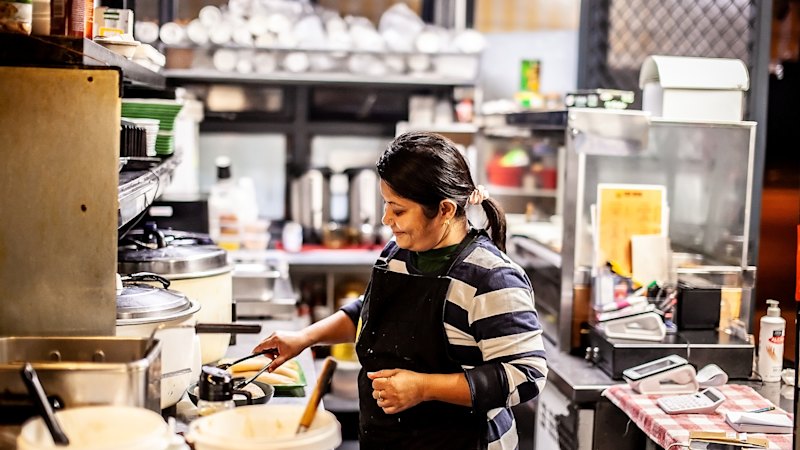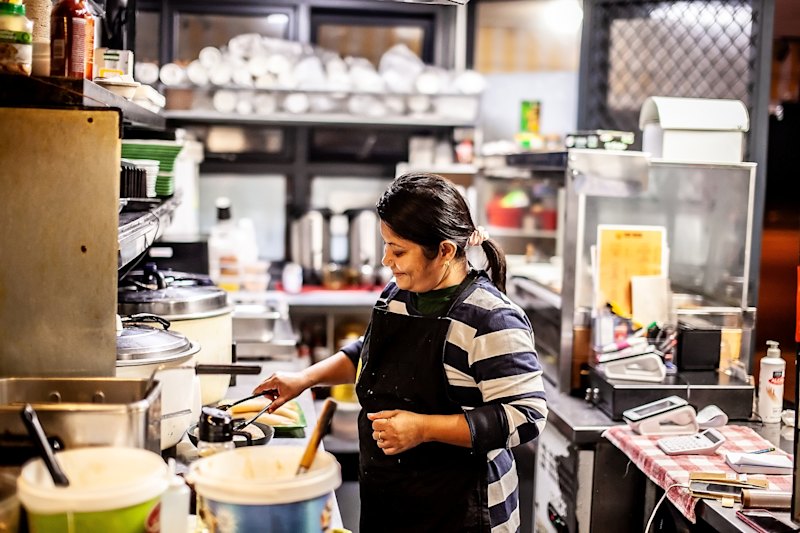
“This is the
morog pulau
,” smiles Janet Faldeus, the Bengali chef-owner of Authentic Family Recipes, as she brought my chicken pilaf lunch order to the table. “I hope you like it.”
How could I not? The medium-grain rice was fluffy and full. The chook was supple-as and cloaked in a khaki-coloured curry onesie: creamy, mellow and comforting. A little bowl with more of the sauce was nestled into the rice. As far as introductions to the pleasures of Bangladeshi food go,
morog pulau
– one of the country’s national dishes – is a good place to start, as is this homely canteen in East Vic Park.

For those that know (or knew) Authentic Family Recipes as a safe bet for fortifying Indian-Malay-Singaporean comfort food, news that it is now a Bangladeshi restaurant may come as a surprise. It certainly was for me when I visited in October and discovered Faldeus was the restaurant’s new owner and had change on her mind. Half a year on and that surprise has slowly been replaced with delight.
Still, signs of the restaurant’s past life remain. (The signage outside, for instance.) As she did for us then, Feldaus will cook you a flaky prata if you ask. True, it won’t be stretched by hand like the ones served at
Suzie’s Makan Place
or
Rasa Sayang
but let’s be real: frozen prata is still pretty good. (Not least when you get home after a night out and remember that there’s a packet of it in the freezer.)
The more uniquely Bengali breads and snacks, though, are house-made and reason enough to visit, none more so than the Bangladeshi street food favourite.
chitoi pitha
: savoury, Twinkie-shaped rice flour cakes that are steam-baked in moulded, covered pans to render their underside chewy while keeping their core fluffy. They’re great as is but truly shine when slicked with one of the accompanying two
vorta,
the Bangla word for condiments. In the red corner: a thick
shutki
heady with smoked fish. In the green: a zippy chutney of coriander and chilli that reminds me of the mighty Yemeni relish,
zhug
.
While the
chitoi pitha
are cooked on the stovetop, most of the breads originate from the fryer. There’s
luchi
: planks of bubbly flatbread that are, in a nice way, lighter and blonder than you’d expect. Sturdy samosas conceal fillings both usual (spiced potato, say) and less-so. (That’d be the beef liver.) Bangladeshi-style
dal puri
equals discs of enriched dough fried to caramel-golden, smooshed with lentils and served with a sweet tamarind water: think of them as a flat-earther-friendly version of Indian’s legendary filled wheat spheres,
panipuri
and
golgappa
.
But like the bible and medical advice both decree: “man[kind] shall not live by bread alone.” (Matthew 4:4). And so the discussion moves to curry, Authentic Family Recipes’ other main pillar. According to Ferduas, Bangladeshi cooks love to sing songs of fire and spice. Her preference, though, is to keep heat levels low, both for herself and for her customers.
So while curries frequently sport the sort of oily, incandescent red glow that can make the spice-averse nervous, heat levels rarely rise above a mild, PG-13 buzz. All the better to taste whichever protein is lolling in that day’s curry. One day, it’ll be juicy, bone-in goat. The next, honeycomb tripe that’s been chopped into sensible postage-sized chunks and carefully simmered into submission.
I’m not sure when Ferduas is cooking her whole quail curry next, but I hope I’m there when she does, and that the sauce boasts the same haunting richness as the version I ate earlier this month. (The secret, she says, is letting the lot cook for thrice as long as usual.) I hope she’ll share more Bangladeshi-Chinese dishes, too. Thanks to the mellow comfort of “Thai chicken soup” – picture tom yum soup finally circling back to tomato soup’s email about a brand collaboration – served with bowtie-shaped fried chicken dumplings called
onthons
, I’ve discovered a new strain of Chinese fusion food to get nerdy about.
While there’s a laminated menu by the register, it’s little more than set-dressing. Homesick Bengalis will already know what they want and will order it with joyful tears in their eyes. The rest of us will be discretely Googling dish names from both the main carte and handwritten specials whiteboard. My advice? Ignore both and have a chat with Janet. She’ll tell you what’s good and will authorise reshuffles of suggested protein and carb pairings – “chicken chop + lucci ($18)” – if she wants you to try something: a sign, I think, of an enthusiastic first-time restaurateur keen to share her heritage with others.
Wait, I lie. Sort of. Although Ferdaus bought Authentic Family Recipes in October, she also temporarily leased the restaurant for a few afternoons a week in 2020 after COVID. Back then, cooking was something she did for herself: a quiet act of independence that also allayed the monotony of the housewife life. (She only started cooking in Australia and taught herself by reading online recipes and watching YouTube.) This time around, she’s cooking for her family and to support herself and her nine-year-old son following her husband’s passing.
Despite the roughness of the hand that she’s been dealt, Ferdaus has neither the time nor energy to throw herself a pity party. Perhaps it’s because she invests so much of both in her community? Students get discounts. Rough sleepers get fed. (Guests that want to help feed others can slip some banknotes into a white letterbox above the register.)
Everyone gets to dine at a homely, canteen-like space where they can get a meal for less than $20, even if they have to collect their own cutlery and squeeze into small tables that are tightly packed lip-to-lip.
Like many restaurateurs serving the food of the Indian subcontinent, Ferdaus does all of her cooking at once – typically around lunchtime – and then stores everything in bain maries to sell throughout the day. Visit in the evening after a big lunch and you may discover the restaurant’s looking bare, Old Mother Hubbard-style. The solution: come around noon while she’s still preparing the food, even if it’s to get some takeaway for dinner.
The price one pays for access to these early draft picks, though, is potentially leaving the restaurant covered in the distinctive scent of eau de open kitchen.
If you’re not familiar with it, it’s an evocative fragrance that leads with cooking oil, but also includes top notes of forward planning, streetwise dining and victory. I hope, and know, you’ll like it.
Good Food reviews are booked anonymously and paid independently. A restaurant can’t pay for a review or inclusion in the
Good Food Guide.









Leave a Reply